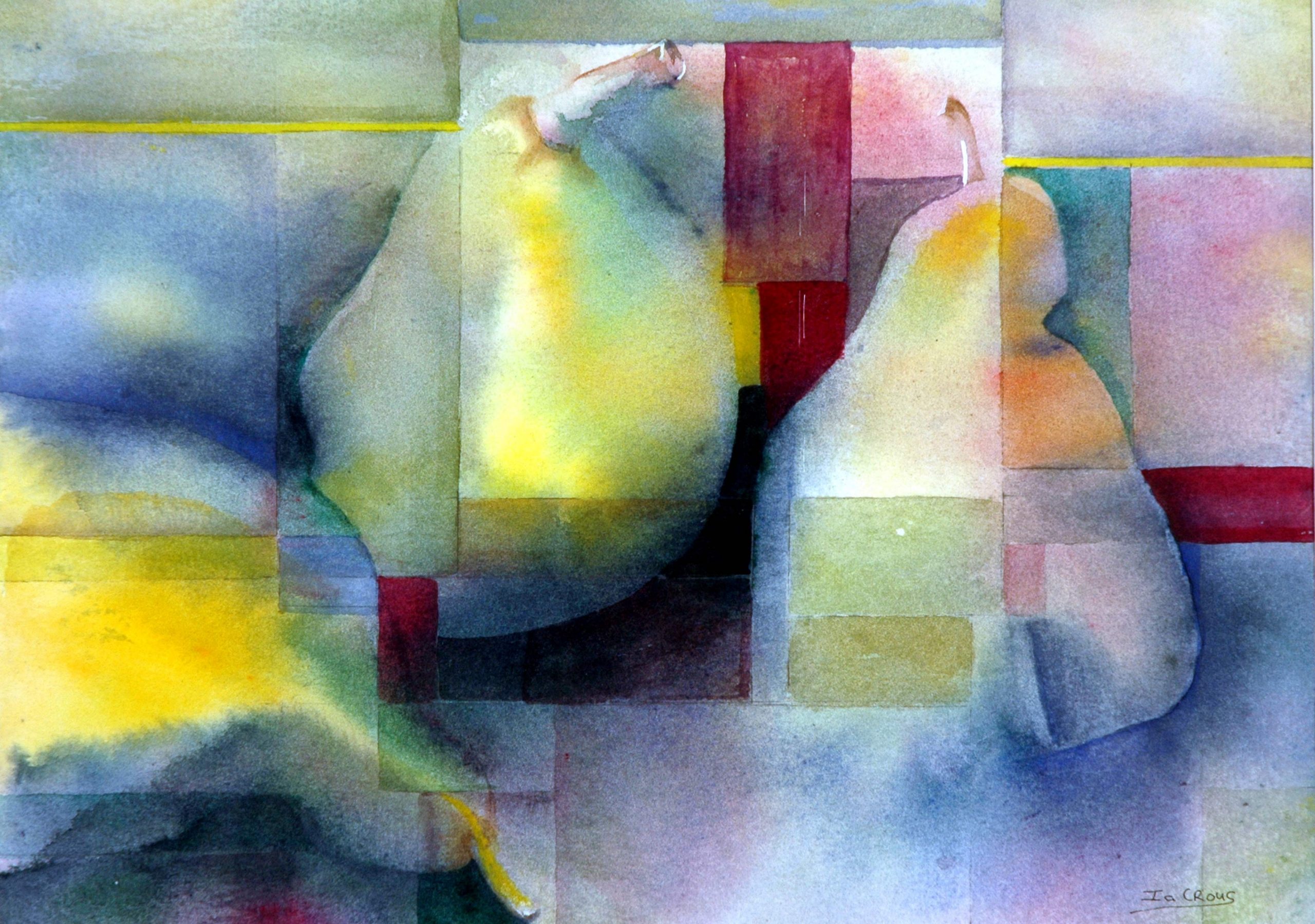IT TOOK A LIFETIME TO CREATE THIS PAINTING OR MAYBE JUST A FIVE MINUTES
How long did it take to do this artwork? This is a simple question. The artist wonder if time is important for the viewer to calculate the price asked. When the answer is that it took a lifetime, it is part of the truth. It took the artist her whole career to get to this point. If the answer is that it took only five minutes, it is also part of the truth. So, what is the mystery answer to this tricky question?
Be true to yourself.
Back home, I was disappointed in the outcome of the painting. I submersed the painting in a bath of water and left it there for almost five hours and then let it dry overnight.
The next morning, I suddenly had the urge to express myself via the “boxes”. You can still see the pears, but it turned out to be an abstract piece of art. The “box idea” was my way to rebel the notion to put people/artists in boxes.
I asked a viewer why this watercolor painting was of so much interest. The answer came: “…because of the emotion it portrays”. I told the story behind the painting to this viewer, and “Pears” was sold. Communication with the viewer/ potential buyer through art, is important, but stay true to yourself.
Even with the best intensions and sound foundation of knowledge, some mishaps/mistakes will occur. “Pears”, as a still life watercolor painting, is such an example. I was disappointed with the painting I did in class. To my mind I made a mistake. How can an artist overcome mistakes?
What are the three most needed factors to control or rectify mistakes?
The first factor to rectify a painting gone wrong is to acknowledge the fact that you made a mistake. Secondly, spend a lot of time to understand what went wrong and study more. Lastly, don’t be afraid to experiment.
ACKNOWLEDGE YOU MADE A MISTAKE
One of the most difficult decisions to make, is to acknowledge the fact that you made a mistake. First you must tell yourself that a piece of your creation in not up to standard.
Why is this an important step? You are first and foremost just human. This will help you to forgive yourself. Now you are free to tackle the problem and solve it.
How do you know what to do?
SPEND A LOT OF TIME TO STUDY
Nine eight percent (98%) of your time must be spent to study, to read more, and to learn from other artists.
You are familiar with “Old Masters” who learned from each other. They made mistakes, but they kept creating.
When you talk to successful fellow-artists, you will soon learn that they also grow by making mistakes.
The question arises what do modern artists do to become well known artists? They keep creating.
Common characteristics between the old masters and the modern artists, is in the first place to keep creating and secondly don’t afraid to experiment.
DON’T BE AFRAID TO EXPERIMENT
Pears was my first “experiment”. According to an art teacher, who’s classes I attended, the public should never know that we as artist’s are experimenting. The line of argument was (and sometimes still is) that we would defy buyers’ trust. Nothing, to my mind, could be further from the truth.
The curious mind wants to experiment. The question remains: what if? Experimentation open new possibilities and new possibilities create new inspiration.
INSPIRATION IS THE ACTUAL CREATION THROUGH PERSPIRATION
Inspiration is like a burst of falling stars, pouring through my artistic system, which can be very tiring. To catch that one perfect star takes time, a lot of time and of course perspiration
When I create, my whole body is engaged. I smell, hear, see, touch, and taste the scene I’m creating. Having said that, what I don’t experience, is my immediate surroundings. Time, the doorbell, the rest of the family, keeping my overcoat, palette, hands and easel clean, are all irrelevant.
This is one of the stages of my creating process, where only my artist’s brain is in control. This part is the 2% activity I really love and live for.
Apart from the medium, surface, and color to express yourself, words have another way to say it all.
How long did it take?
It took five minutes to submerge the painting into a bath of water. It took a lifetime to remember why it was the right thing to do. It took a lifetime to learn how to rectify a mistake.
The connection between the artwork PEARS, the viewer and the artist were further emphasized through some golden words of wisdom, and thoughts.
- A pear-shaped lady is dressed in white and wears a pair of silver shoes.
- To bake a New Year’s Pear pie, you must pare away the skin of the pear.
- Even the well-known sweet dish of pears cooked in red wine, cannot take away the fact that the flower of the pear tree is foul scented.
- It takes a long time for a pear tree to bear fruit.
Thank you for reading “FIVE MINUTES OR A LIFETIME”.
You may also be interested in THE POWER, PASSION AND SYMBOLISM OF THE POMEGRANATE.
EDITOR’S NOTE: This post was last published in May 2016 and has been completely revamped and updated for more comprehension.
Rewritten by Ia Crous, May 2020. Viewers often wonder how long it took to complete a painting. There is no one accurate answer to this. Various factors are to be kept in mind. The style, medium, expertise, nature and temper of the artist are factors that will play a role. Acknowledge mistakes, forgive yourself and take risks to rectify your error. Inspiration will come though perspiration and it will be intensified by study.



0 Comments